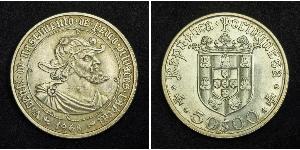50 Escudo (sold for $21.0)
1968, Portugal (Republic). Beautiful Silver 50 Escudos Coin. aXF!
Mint Year: 1968
Reference: KM-593.
Condition: Lightly cleaned, otherwise XF!
Denomination: 50 Escudos - Pedro Álvares Cabral Anniversary
Material: Silver (.500)
Weight: 17.93gm
Diameter: 34mm
Obverse: Togate and helmeted bust of Pedro Álvares Cabral right.
Legend: V . CENTN. DO . NASCIMENTO . DE PEDRO . ALVARES . CABRAL - 1868 -
Reverse: Coat-of-arms of Portugal infront of Cross of Jerusalem.
Legend: REPUBLICA . PORTUGUESE * + * 50 $ 00 * + *
Pedro Álvares Cabral (c. 1467 or 1468 – c. 1520) was a Portuguese noble, military commander, navigator and explorer regarded as the discoverer of Brazil. Cabral conducted the first substantial exploration of the northeast coast of South America and claimed it for Portugal. While details of Cabral's early life are sketchy, it is known that he came from a minor noble family and received a good education. He was appointed to head an expedition to India in 1500, following Vasco da Gama's newly opened route around Africa. The object of the undertaking was to return with valuable spices and to establish trade relations in India—bypassing the monopoly on the spice trade then in the hands of Arab, Turkish and Italian merchants.
His fleet of 13 ships sailed far into the western Atlantic Ocean, perhaps intentionally, where he made landfall on what he initially assumed to be a large island. As the new land was within the Portuguese sphere according to the Treaty of Tordesillas, Cabral claimed it for the Portuguese Crown. He explored the coast, realizing that the large land mass was probably a continent, and dispatched a ship to notify King Manuel I of the new territory. The continent was South America, and the land he had claimed for Portugal later came to be known as Brazil. The fleet reprovisioned and then turned eastward to resume the journey to India.
A storm in the southern Atlantic caused the loss of several ships, and the six remaining ships eventually rendezvoused in the Mozambique Channel before proceeding to Calicut in India. Cabral was originally successful in negotiating trading rights, but Arab merchants saw Portugal's venture as a threat to their monopoly and stirred up an attack by both Muslims and Hindus on the Portuguese entrepôt. The Portuguese sustained many casualties and their facilities were destroyed. Cabral took vengeance by looting and burning the Arab fleet and then bombarded the city in retaliation for its ruler having failed to explain the unexpected attack. From Calicut the expedition sailed to the Kingdom of Cochin, another Indian city-state, where Cabral befriended its ruler and loaded his ships with coveted spices before returning to Europe. Despite the loss of human lives and ships, Cabral's voyage was deemed a success upon his return to Portugal. The extraordinary profits resulting from sale of the spices bolstered the Portuguese Crown's finances and helped lay the foundation of a Portuguese Empire that would stretch from the Americas to the Far East.
Cabral was later passed over, possibly as a result of a quarrel with Manuel I, when a new fleet was assembled to establish a more robust presence in India. Having lost favor with the King, he retired to a private life of which few records survive. His accomplishments slipped mostly into obscurity for more than 300 years. Decades after Brazil's independence from Portugal in the 19th century, Cabral's reputation began to be rehabilitated by Emperor Pedro II of Brazil. Historians have long argued whether Cabral was Brazil's discoverer, and whether the discovery was accidental or intentional. The first question has been settled by the observation that the few, cursory encounters by explorers before him were barely noticed at the time and contributed nothing to the future development and history of the land which would become Brazil, the sole Portuguese-speaking nation in the Americas. On the second question, no definite consensus has been formed, and the intentional discovery hypothesis lacks solid proof. Nevertheless, although he was overshadowed by contemporary explorers, Cabral today is regarded as a major figure of the Age of Discovery.
Only 1$ shipping for each additional item purchased!

|
Posted by:
anonymous 2014-05-22 |
|
||
|
||
|
||
|
||
One of them is

-600-300-RgoKbzbiVw0AAAFGWsPAdCGs.jpg)

-300-150-RgoKbzbiVw0AAAFGWsPAdCGs.jpg)
 English
English














